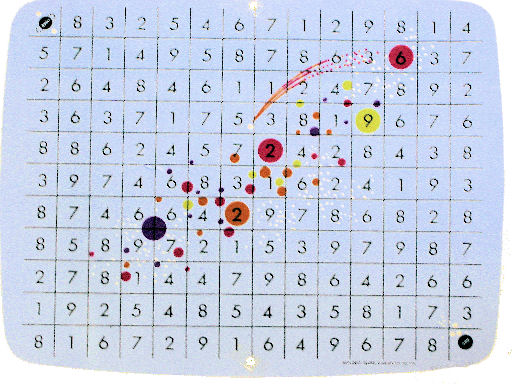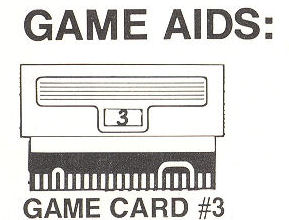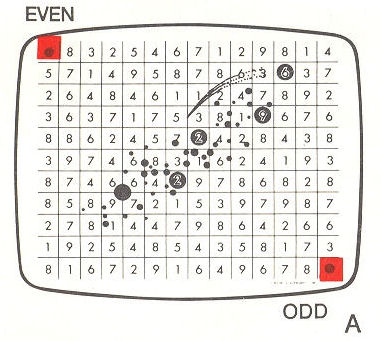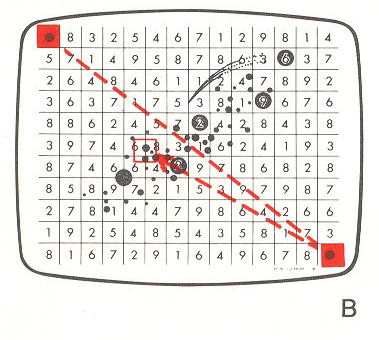
Analogic - a game for two players - is a space race through the numeric maze of a computer charted galaxy.
The Magnavox producer of this game says that it is a "fascinating addition game for people of all ages.
SET UP | |
|---|---|
 |
1. Insert Game Card #3 into the Master Control Unit. 2. Turn the SPEED control to the slowest setting. |
 |
3. Place the ANALOGIC Overlay on the screen. 4. 16 Red Chips are used in this game. |

| 5. Illustration A. Using HORIZONTAL and VERTICAL Controls, the left player, Player 1, goes to the planet EVEN. The right player,
Player 2, goes to the planet ODD. 6. Both Players set their ENGLISH controls to the upright center position. |
HOW TO PLAY | |
 |
Illustration B. The players establish interstellar contact by activating their light beam transceivers.
(The RESET button is pushed and the light bounces diagonally between both players. Use the ENGLISH control to
determine the correct path of the light.)
The players flip a coin to see who moves first. The player from the planet ODD tries to reach the planet EVEN before the player from the planet EVEN reaches the planet ODD. If the player from the planet ODD starts the game, he may move only to an odd numbered square. If the player from the planet EVEN starts the play, he may move only to an even numbered square. |
 |
Illustration C. The players may move one square in any horizontal or vertical direction.
They may, under special circumstances, move in a diagonal direction. This will be explained later.
The principle for the succeeding moves of the game: The EVEN player may move only to a square whose number combines with ODD'S last move to total to an even number. ODD may move to a square whose number totals to an odd figure when combined with EVEN's last move. EXAMPLE: ODD plays first. ODD moves to three EVEN moves to five (3 + 5 = 8) ODD moves to six (5 + 6 = 11) EVEN moves to two (6 + 2 = 8) and so on... NOTE: Each player must total figures aloud before they move. Each player uses his ENGLISH control to maintain interstellar contact. If the player who has control of the interstellar beam misses contact, he must go back one space and his opponent receives a Diagonal chip good for one diagonal move at any time during the game. (Use RESET button to reactivate the beam.) |
 |
Illustration D. Once the players are within any three vertical columns of each other, interstellar contact is no longer necessary and the beam is allowed to disappear off the screen. |
 |
Illustration E. When a player passes through the Planetary Belt, he receives a Diagonal chip for each
time he touches one of the five planets. Players may not occupy the same square at the same time.
The first player to reach his opponents planet wins the game. |
GAME VARIATION: Use the interstellar light as a timer for the game of play. Each player must announce his moves within four traverses of the beam or he forfeits his turn. All other playing procedures remain as outlined.
Last update March 17, 2010